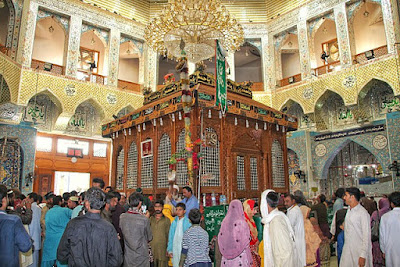Jhulelal- A Fluid Identity
‘He whom you call Allah and my people call Krishna, are but one and the same!’... ‘Jhulelal’ Lal Shahbaz Qalandar

Hindus look upon him as
their saint - their incarnation of the god, and Muslims look upon him as a Sufi
saint. While Muslims revered Lal Shahbaz as a saint, Hindus saw him as an
incarnation of Jhulelal.
Jhulelal goes by
several names: Udero Lal (meaning “the one who has sprung from the water”,
Varundev, Dariya Lal (the Red River), Zinda Pir (the Living Saint), and Lal
Sai. His most popular name, Jhulelal, comes from a story of his crib swinging
by itself, hence the word “jhula,” meaning “swinging,” attached to him as a
nickname. Varundev is a common identity in the Karachi area, as Udero Lal was
considered a reincarnation of the Vedic deity Varuna, the god of the river. The
Sri Varundev Mandir on the island of Manora in Karachi is devoted to the
worship of the Hindu deity Varuna, including all of his reincarnations.
Jhulelal is not a
regular Hindu/Sindhi/Sufi/Islamic deity. For one, Jhulelal or Daryalal is known
and worshipped in many forms, across religious sects. Although there are
several tales of Jhulelal known across Sindh and the global Sindhi diaspora,
there is a complex synergy between Jhulelal, Lal Shahbaz Qalandar of Shehwan,
Shaikh Tahir of Uderolal and Khwaja Khijr, worshipped at different times by
different groups. The link that connects these deities and saints is singular:
The Indus River. Jhulelal is a part of the Daryapanthi or Daryahi sect which
worships the Indus, a form of river or water worship that may have its origins
dating back to the ancient Mohenjo-daro civilisation.
Jhulelal and the composite sect of saints are also known interchangeably as the Zinda Pir or Jind Pir: The Living Saint.
How did Jhulelal become
a saint of the Muslims?
He is said to have
appeared on the island of Khwaja Khizr near Sukkur, in Sindh, to save a Muslim
woman who was coveted by a Hindu king. He is said to have finally disappeared
from the village of Jahejan, later renamed as Udero Lai, where he had asked his
followers to build two sanctuaries in the same complex: One for his Hindu
followers, a samadhi, and another one for his Muslim followers, a “qabr”.
This wonderful
symbiosis of religions under the guardian saint singing in the Sindhi language
lasted for three centuries and moulded the personality of the Sindhi man who
will not drop a reference to a Hindu god merged in the personality of the saint
of Sehwan. The song has been rendered into Punjabi too and now invades the vast
territory of Punjab. The singers of “Jhulelalan”, like Abida Parveen, have
become legends in Pakistan. Sindhis all over the world greet each other with the
words, “Jaikochavando Jhulelal thenjathinda Beda-Paar” (Jhulelal will lead you
towards success)”.
However the Sunni orthodoxy
of northern Pakistan, strengthened by their participation in jihad, began to
dominate Pakistan’s ideology in the 1980s. Sunni madrasas, enriched by jihad,
began to penetrate Sindh to “set it right”; and today threaten the foundations
of the pluralist culture of Sindh, particularly by allowing forcible marriages
of Hindu girls to Muslims. The mausoleum of Lal Shahbaz Qalandar in Sehwan Sharif
was targeted again and again as Muslims and Hindus sang and danced together at
the shrine. In February 2017, a “suicide” bombing at the shrine killed 88,
including women and children. The attack was carried out by the Islamic State
(ISIS), the Sunni terrorist gang born in Iraq to avenge the rise of the Shia
majority there. Its presence in Pakistan together with al Qaeda threatens the
way of life of the Pakistani people, as shown by this attack, carried out by a
local Muslim converted to violence. Not long ago the mausoleum of Data Ganj
Bakhsh was suicide-bombed in Lahore, where not long ago Hindus, Sikhs, and
Muslims lived peacefully together and accepted the mystic saint as the guardian
spirit of the city.
A bridging Prophet-
Jhulelal
Jhulelal laid stress on
unity, on the supremacy of intelligence and of the intellect, and on breaking
down the barriers of caste and creed. To promote and ensure this
unity, the Sindhis celebrate the day of Cheti Chand and refer to it as
'Sindhiat' day, sacred to all Sindhis, be they Hindus or Muslims. On this
auspicious day, fairs are organised all over the country, where people get
together. They sing and dance; they eat and drink sweet drinks of milk mixed
with pounded poppy seeds and ground almonds. They sing penjiras (series of
couplets in praise of the River God) and Arti, songs that express their love
of, and praise for Jhulelal.
Today, Sind is no longer shown on the map of India, for it is now a part of Pakistan. Yet Sind is everywhere. Wherever the Sindhis are, Sind lives and breathes, a vivid and vital thing, for everywhere the Sindhis have held aloft the banner of their individual identity, even though they have merged with the people of the areas in which they live.

References-
- Jhulelal or Zinda Pir: Of river saints, fish and flows of the Indus (Scroll.in)
- Jhulelal: The God of the Indus (https://www.livehistoryindia.com/)
- Jhulelal (Sufism) - OER2Gooer2go.org



Comments
Post a Comment